
Visiting the Galapagos Islands is on many traveler’s bucket list and for good reason. This unique volcanic archipelago is a haven for breathtaking aquatic and terrestrial wildlife, each island a self-contained world with its own species and scenic highlights to witness. There are 127 islands, islets and rocks in total. With so many to choose from, how do you know which are the best Galapagos islands to visit?
To make things a little easier, we can eliminate the smaller islets and rocks which leaves us with 20 main islands to consider, but we can whittle our choice down further by eliminating the following:

Daphne
To help with the rest, we’ve compiled a list of the 15 best islands to visit in descending order, based on the opinions of our Galapagos destination specialists and many of the Galapagos National Park guides themselves, taking into account the uniqueness of their visitor sites and prevalence of iconic species. Please note that this doesn’t take into account the geography of the islands. For example, visiting some of the islands may not be feasible in conjunction with visiting others in the same itinerary if they are other ends of the archipelago.

Santa Cruz
This is the second-largest island in the Galapagos and is the most populated with some 12,000 locals. Puerto Ayora is located in Santa Cruz, the most populated town on the Galapagos. The town boasts a hospital, schools, banks, shops, hotels, restaurants, and numerous Internet cafes. Overall, it has the best infrastructure in the Galapagos. There are a variety of tours that can be designed by tourists from Santa Cruz including kayaking trips, hiking tours of the highlands, diving and snorkeling excursions, horseback riding outings, and boat trips to nearby islands.
The Charles Darwin Station is a must-see on Santa Cruz. It is located about 1km west of Puerto Ayora and contains fascinating and detailed information about the history of the flora and fauna of the Galapagos. Tortuga Bay is another must – a beautiful beach filled with a profusion of wildlife that includes the Giant tortoise, Marina iguanas, Galapagos crabs, and Whitetip sharks. Garrapatero Beach is also unique and no guide is needed to visit; swimming and snorkeling are also allowed. There is a small lagoon situated behind the beach where flamingos and Bahamas ducks can be spotted. Las Grietas is similarly remarkable – a canyon filled with crystal clear waters and an abundance of tropical fish.
Human Population: Approximately 12,000
Santa Cruz Island Area: 986 km² or 381 mi²
Santa Cruz Island Altitude: 864 m or 2835 ft
This Island is known for its red beaches and overall red appearance due to large quantities of iron in the lava. Its one of the most volcanically varied islands in the Galapagos. Flamingos previously inhabited the island but moved due to a lack of food. In 1971, the park service managed to eradicate goats that were destroying the wildlife but not before geckos, land iguanas and rice rats all became extinct from the island. Today you can find marine iguanas, sea lions, blue-footed boobies and Nazca boobies. Rábida Island is a great place for visitors to see Brown Pelicans nesting up close.
Human Population: 0
Rábida Island Area: 4.9 km² or 1.89 mi²
Rábida Island Altitude: 367 m or 1203 ft

Bartolomé
This is a volcanic islet with no human population and it is one of the newer Galapagos islands. It was named after a good friend of Charles Darwin, Sir Bartholomew Sullivan, who was the captain of the HMS Beagle. The island is renowned as the filming location for the blockbuster movie ‘Master and Commander and for being the home to the Galapagos Penguin. Pinnacle Rock is a must-see on the island and the adjacent beaches are filled with a wide array of wildlife; sea turtles lay their eggs on the north beach between January and March and other tropical fish and sea lions can be seen whilst snorkeling and diving in the area. It is prohibited, however, to swim on the southern beach but it is still worth a visit as Spotted Eagle Rays and Black-tipped Sharks can be commonly viewed.
Human Population: 0
Bartolomé Island Area: 1.2 km² or 0.5 mi²
Bartolomé Island Altitude: 114 m or 375 ft
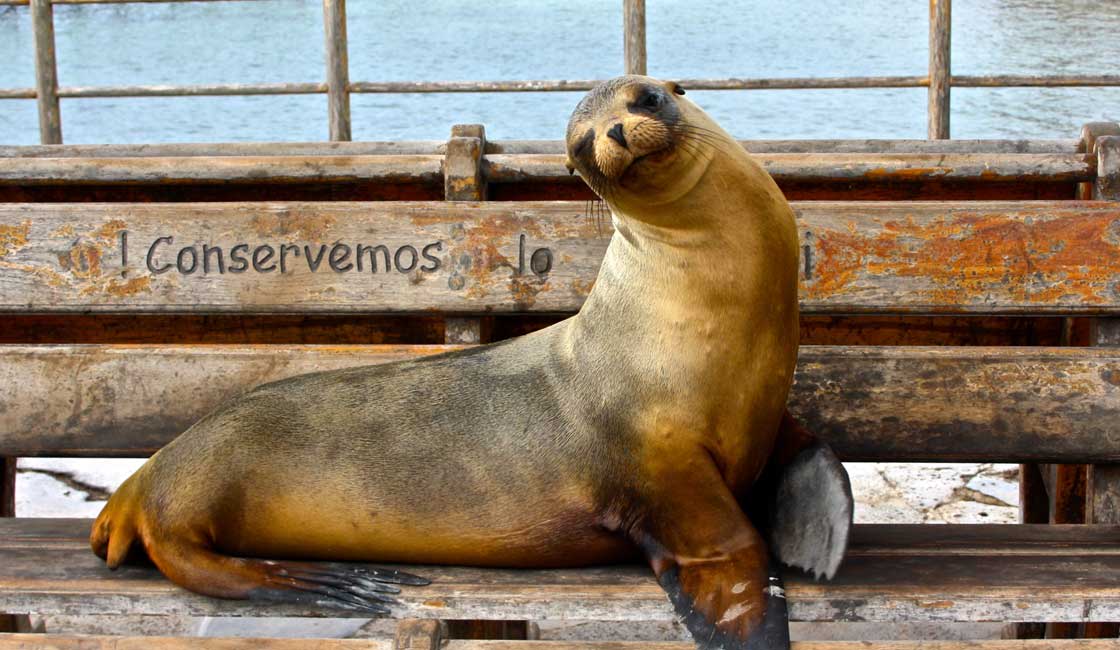
San Cristobal
This is where Charles Darwin first came ashore in 1835. The island is the home of a small lake (laguna el junco) and this is the only freshwater source on the Galapagos. The population of San Cristobal is around 6,000 people and it is the most fertile of the islands. The town of Puerto Baquerizo Moreno is the capital of the Galapagos province and it is the home to government offices, an Ecuadorian Naval facility, and an airport. The majority of the inhabitants have professions in government, the tourism industry or fishing. The island is more susceptible to the introduction of new, potentially dangerous species due to the airport and some 20 years ago, the black fly was introduced. This has caused serious problems for the local farmers, as they tend to suck the blood out of mammals leaving a poison that in some cases is fatal.
There are a number of tourist destinations on the island: Cerro Brujo is a picturesque coral and sand beach and is a spectacular place to swim and snorkel in the clear blue water. Sea Lions sometimes rest on the beach and coastal and migratory birds can frequently be seen including pelicans and Blue-footed boobies. There are other scenic beaches on the island including Ochoa beach, Sapho cove, and Puerto Chino. There are also numerous snorkeling and scuba diving locations where manta rays, turtles, a variety of tropical fish, and sharks can be spotted.
Human Population: Approximately 6000
San Cristobal Island Area: 557 km² or 215 mi²
San Cristobal Island Altitude: 730 m or 2395 ft
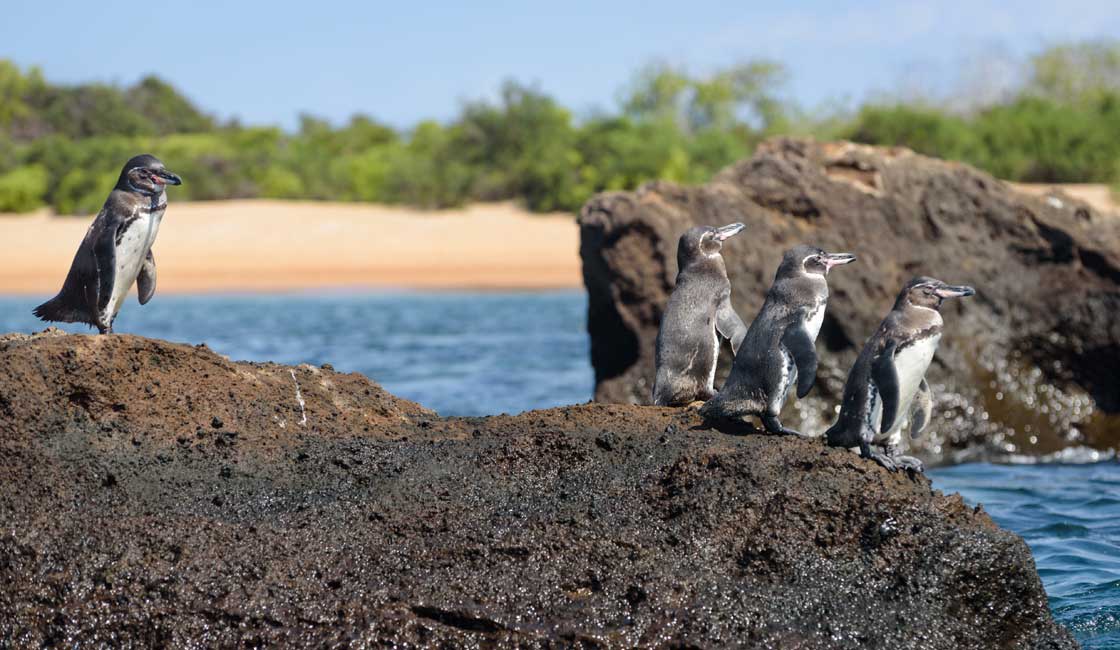
Santiago
The main attraction on Santiago island is Puerto Egas on the west of the island. There is a lava shoreline where eroded rock is the home to a variety of wildlife including iguanas that bask in the sun and tide pools that contain thousands of Sally Lightfoot crabs. The snorkeling is also fantastic as much tropical fish can be viewed.
The focus on conservation on Santiago has been a success over the last decade, as previously, non-native species had been introduced causing severe problems to the local flora and fauna. Goats caused massive erosion through trampling and competed for much of the food with the local herbivores; pigs dug up turtle nests as well as other ground-nesting birds and destroyed their eggs and donkeys were destructive to the Opuntia cactus. Major conservation projects led to the eradication of these species leading to rapid recovery. This island is regaining a pristine status.
Human Population: 0
Santiago Island Area: 572 km² or 221 mi²
Santiago Island Altitude: 905 m or 2974 ft
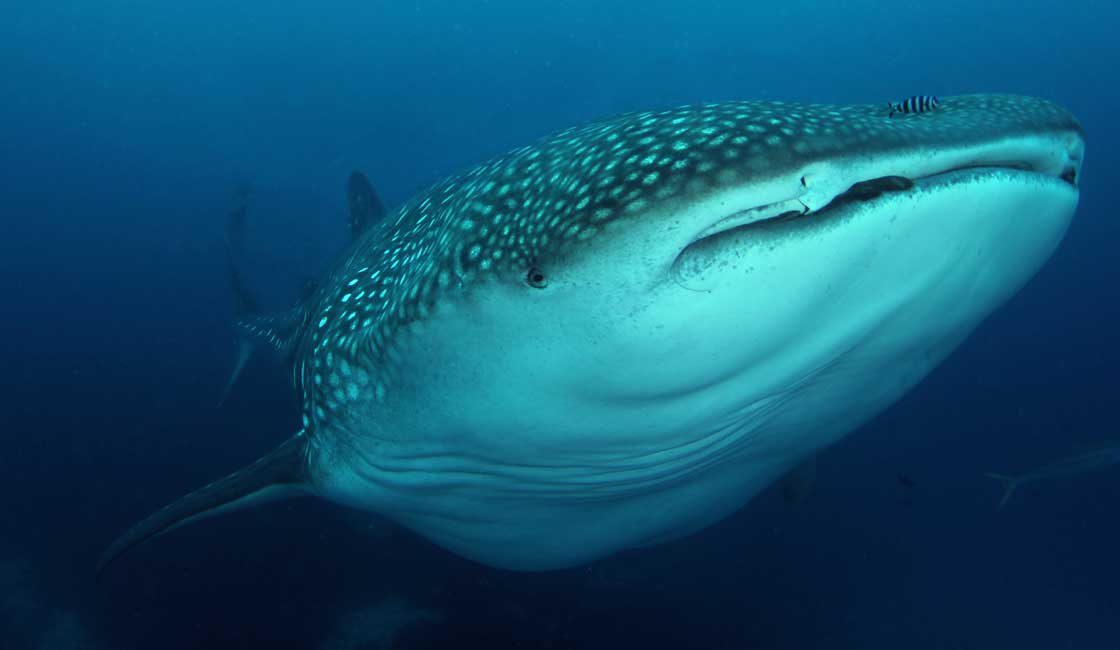
Darwin & Wolf
These two close islands are only visited together, so much so that we’ve decided to group them. They are barely visited by regular tourists as they are two of the most remote islands in the archipelago, but are world-famous among scuba divers. Wolf is named after the German geologist, Theodor Wolf, and is home to a large range of marine wildlife: schools of Hammerhead sharks can sometimes be seen, Galapagos and Whale sharks, sea turtles and manta rays too. Darwin Island is named after Charles Darwin himself. It is uninhabited by humans but home to fur seals, marine iguanas, sea lions and often whales. The Sooty Tern chooses this Island exclusively to breed on., it will not breed on any other Galapagos Island. The main attraction of Darwin Island is the “Darwin Arch,” dive site, a remarkable stone arch formation.
Human Population: Wolf 0, Darwin 0
Area: Wolf 2.85 km² or 1.1 mi², Darwin 2.33 km² or 0.9 mi²
Altitude: Wolf 253 m or 830 ft, Darwin 168 m or 550 ft
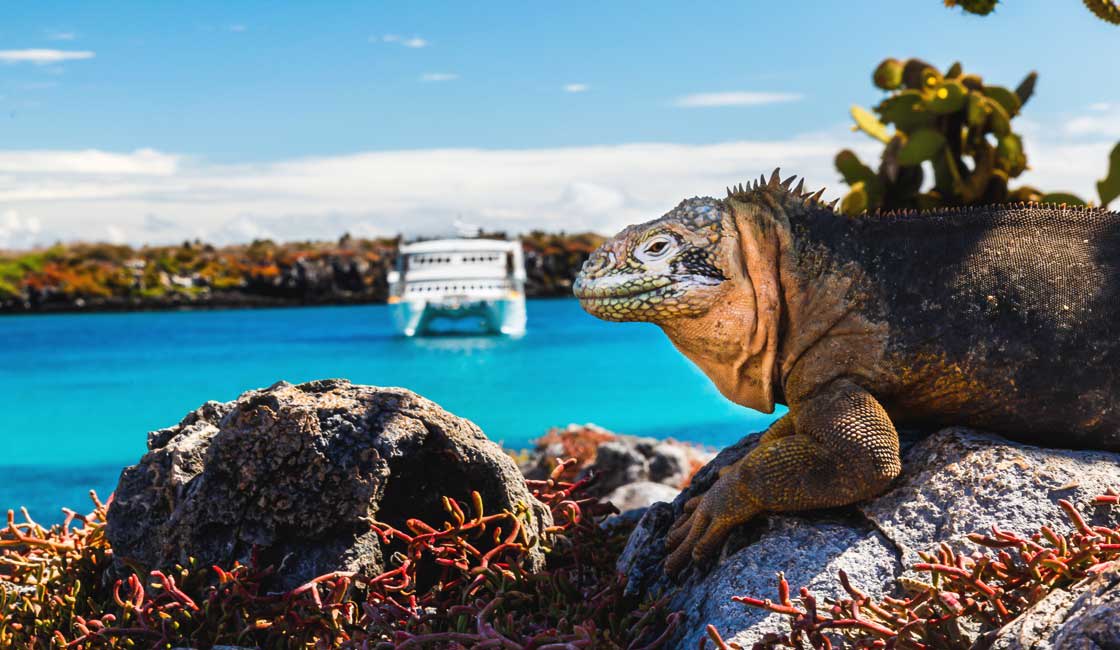
South Plaza
As mentioned already, of the two crescent-shaped Plazas Islands located off the east coast of Santa Cruz, South Plaza Island is the only one accessible to tourists. It has a visitor site and is popular for day trips from Puerto Ayora. It is home to a variety of typical Galapagos wildlife including sea lions, land iguanas, swallow-tailed gulls, and red-billed tropicbirds. South Plaza Island is best known for its flora, as it is home to the succulent Sesuvium plant and many prickly pear cactus trees.
Human Population: 0
South Plaza Island Area: 0.13 km² or 0.05 mi²
South Plaza Island Altitude: 23 m or 75 ft
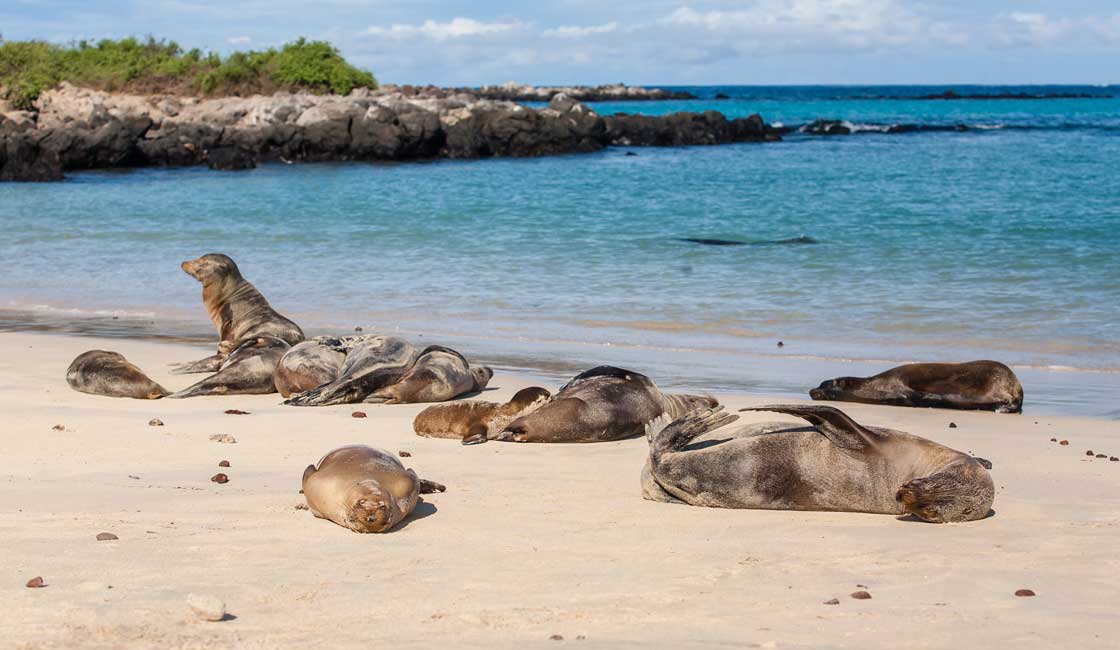
Santa Fé
This is a small island and is a common destination for day trips from Santa Cruz. A variety of plants and wildlife can be seen in the Opuntia cactus forest including, not surprisingly, the Opuntia cactus, the Galapagos dove, Yellow Warblers, lava lizards, and the endemic Santa Fe Land Iguana.
Human Population: 0
Santa Fé Island Area: 24 km² or 9.3 mi²
Santa Fé Island Altitude: 259 m or 850 ft
There is no human activity on this island and it is very rarely visited, not even by scientists or park rangers, however, it is possible to snorkel and dive in the surrounding waters, and its Punta Mejia site one of the best in the archipelago for snorkeling with rays, reef sharks and sea turtles. The Marchena Lava Lizard is endemic to this island.
Human Population: 0
Marchena Island Area: 130 km² or 50 mi²
Marchena Island Altitude: 343 m or 1125 ft
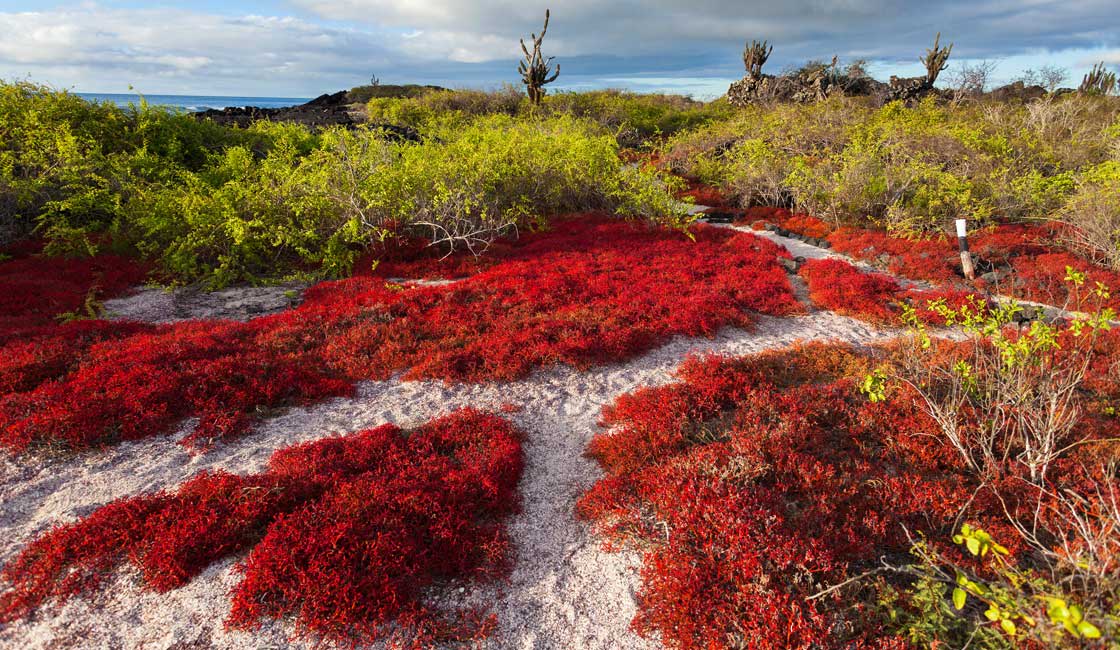
Floreana
This is the longest inhabited island in the Galapagos and was used as a food and water source by pirates and whalers in the 17th and 18th centuries. Floreana is also notorious for a series of mysterious disappearances that occurred in the early 20th century including an Austrian baroness Von Wagner Bosquet and her three servants. Human presence, unfortunately, has had disastrous consequences on the wildlife and as a result, the native Florena tortoise became extinct. Rats, goats and pigs were also introduced on the island and these animals completely destroyed the native flora and fauna.
The famous Post Office Bay is located on Floreana Island. Pirates and whalers used the post office barrel to send their mail and some 300 years later, tourists continue to use it. They will normally leave postcards in the barrel and in turn collect postcards that were left by others. Punta Cormorant is another charming location and it is well known for its volcanic green olivine crystals that can be found on the beach. There is also a trail on the island that offers spectacular views over a saltwater lagoon, which is the home to many birds including the flamingo. The trail continues to a beautiful white sand beach, which is the nesting place for the Green Sea turtle. Devil’s crown is similarly remarkable and is a volcanic crater that has been gradually eroded by the sea. Snorkelers can actually swim into this crater and find an abundance of coral reefs and marine life. This includes the colorful King Angelfish, Balloon fish, Hawk Fish, Sea turtles and at times a variety of sharks including the White Tipped and Hammerhead shark (I must reiterate again, they are completely safe). Puerto Velasco, a very small town on the northwest of the island offers accommodation to tourists who wish to stay on the island. The population of Floreana is no more than 100 people.
Human Population: approximately 100
Floreana Island Area: 173 km² or 107 mi²
Floreana Island Altitude: 640 m or 2100 ft
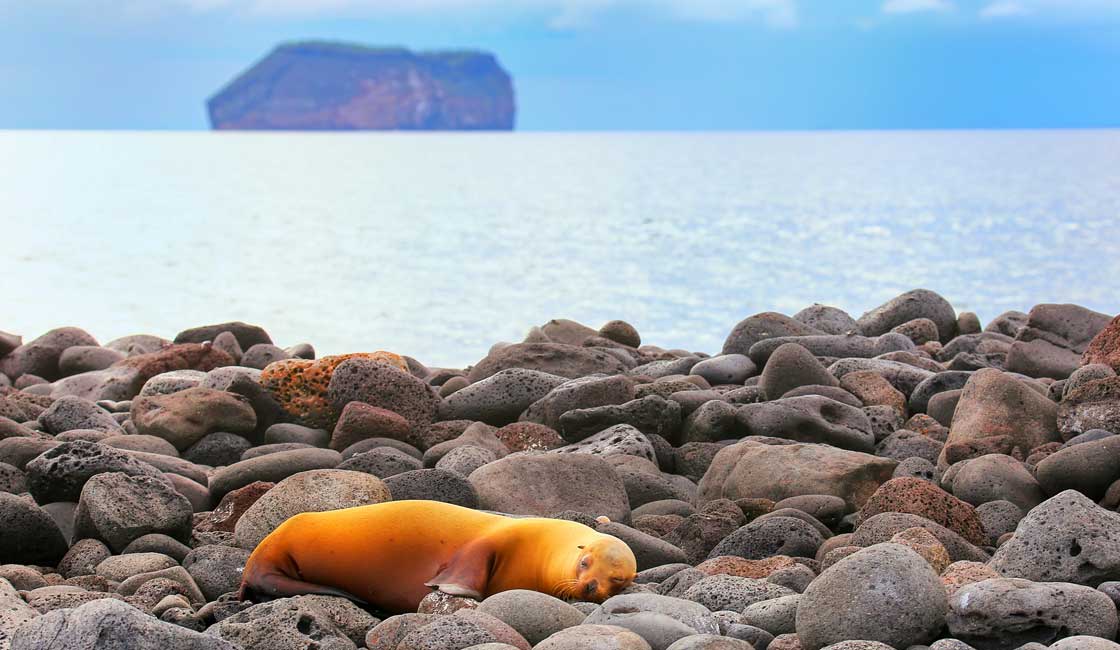
North Seymour
North Seymour Island, located above Balta Island, was named after the English nobleman Lord Hugh Seymour and also lacks a human population. It is the home to an extensive display of birdlife including the blue-footed boobies, whose mating ritual includes a humorous dance, swallow-tailed gulls, and frigate birds who have wingspans of 2.3 meters. The island is also home to over 2,000 land iguanas. The island has a 1.2-mile trail for tourists that cuts into the middle of the island and explores the rocky coast.
Human Population: 0
North Seymour Island Area: 1.83 km² or 1.14 mi²
North Seymour Island Altitude: 28 m or 92 ft
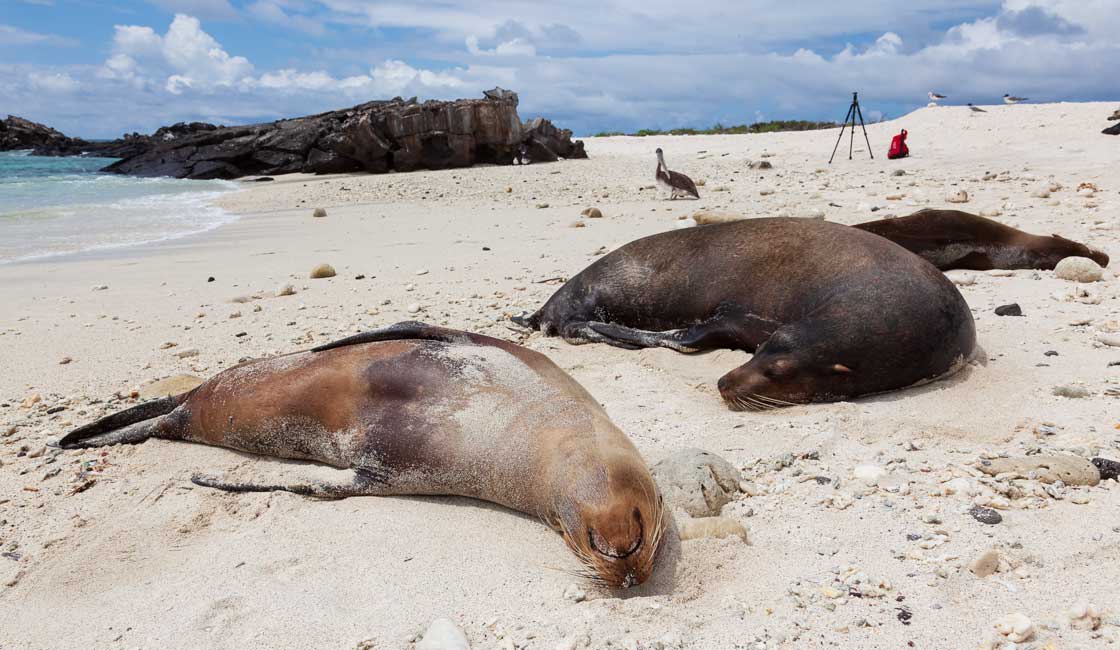
Genovesa
Originally named after Genoa in Italy, this island is a must for bird watching enthusiasts and is often called ‘the Bird Island’. A large colony of Red-footed boobies inhabits Genovesa along with some 200,000 Galapagos Storm petrel. The Short-eared owl, a wide array of finch, the Great Frigate bird, and the Galapagos mockingbird are also indigenous inhabitants. The island is unpopulated by humans and can only be visited with a tour guide.
Human Population: 0
Genovesa Area: 14 km² or 5 mi²
Genovesa Altitude: 64 m or 210 ft
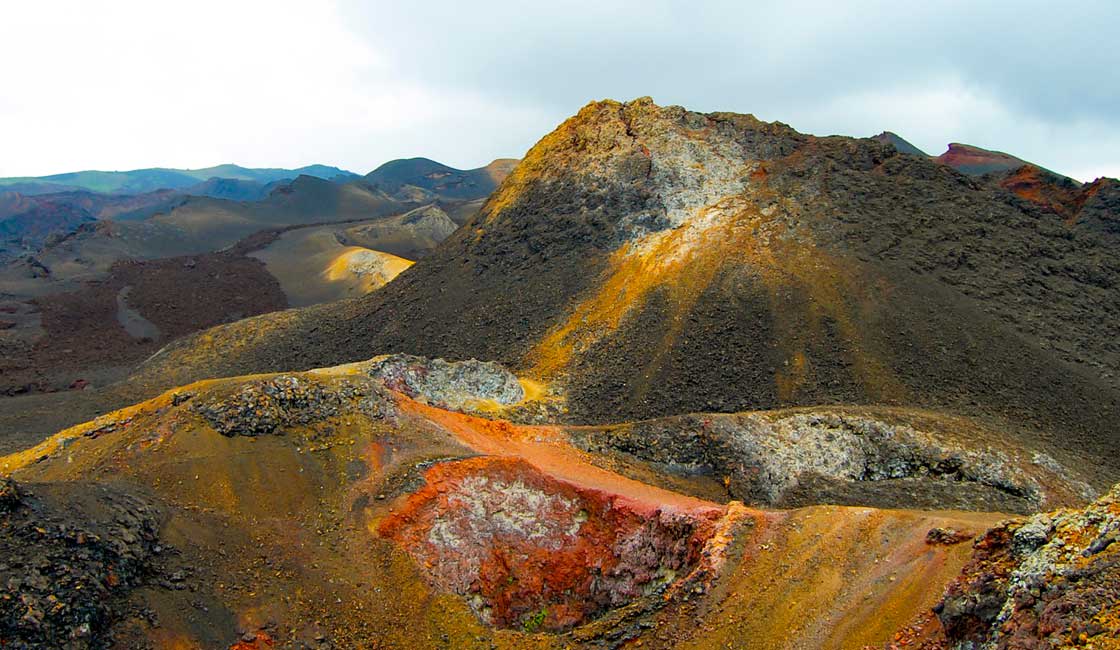
Isabela
Isabela is the largest island in the Galapagos and is bigger than the rest of the islands combined. It’s the third most populated and is the only island to have the equator run through it. Puerto Villamil is the largest town on the island and offers accommodation for tourists. Isabela is accessible by a public speedboat that departs from Santa Cruz Island and there is also a small airfield that is serviced by two local airlines, Embete and Air Zab.
There are numerous sights that should be visited on the island; the Giant Tortoise Breeding Center, only open on weekdays, breeds and raises these Giant tortoises before releasing them into the wild; the enormous Sierra Negra Volcano which boasts impressive views from the rim of the crater on clear days and also boasts the second largest caldera in the world; Las Tintoreras, a lagoon where white tip sharks come to rest and although swimming is prohibited, to watch these sharks in their natural habitat is nonetheless remarkable.
There is also a 3 hour guided hike to the Wall of Tears, a historical site constructed between 1945 and 1959 by prisoners of the Penal colony. It is some 25 meters tall and its construction is said to have caused thousands of deaths. It was supposedly intended to become their prison. The hike itself is overwhelming as picturesque lakes filled with flamingos and beaches packed with iguanas and sea lions can be seen. The west coast of Isabela Island has the nutrient-rich Cromwell Current resulting in a feeding ground for fish, whales, dolphins, and birds. These waters are known as the best place to see whales in the Galapagos: humpbacks, sperms, minkes, and orcas.
Human Population: Approximately 1800
Isabela Island Area: 4670 km² or 1803 mi²
Isabela Island Altitude: 1707 m or 5600 ft
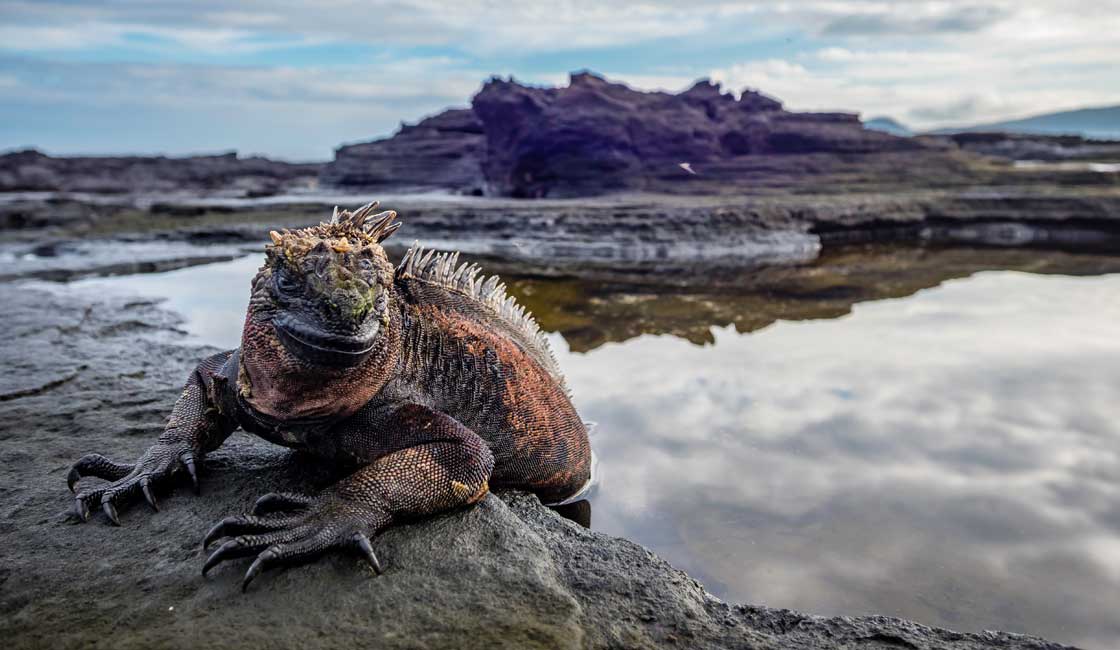
Fernandina
Fernandina Island is the youngest and most westerly lying island, being named in 1832 after King Ferdinand II of Spain. It is actually the site of a shield volcano with the last eruption occurring in April 2009. The island is known for being pristine – this means no rats, goats or any non-native species have been discovered. People do not live on the island and the only sign of human presence is a visitor’s center on the northeast coast.
Punta Espinoza is a must for tourists due to the large numbers of marine iguana that conglomerate on the volcanic shorelines and basks in the sun. Snorkeling and diving are also both common with two dive sites located on the island – keep an eye out for these marine iguanas, Galapagos penguins, and Sea horses that love to play in the crystal clear waters.
The area has also been acknowledged as a whale sanctuary and so Pilot whales, Bryde’s whales and Bottlenose dolphins can frequently be seen from shore. The island has a colder climate, due to the waters from the Cromwell Current that hits the archipelago from the west. Fernandina and western Isabela are the richest waters in the Galapagos, providing prime habitat for both Flightless Cormorants and Galapagos Penguins.
Human Population: 0
Fernandina Island Area: 642 km² or 248 mi²
Fernandina Island Altitude: 1476 m or 4842 ft
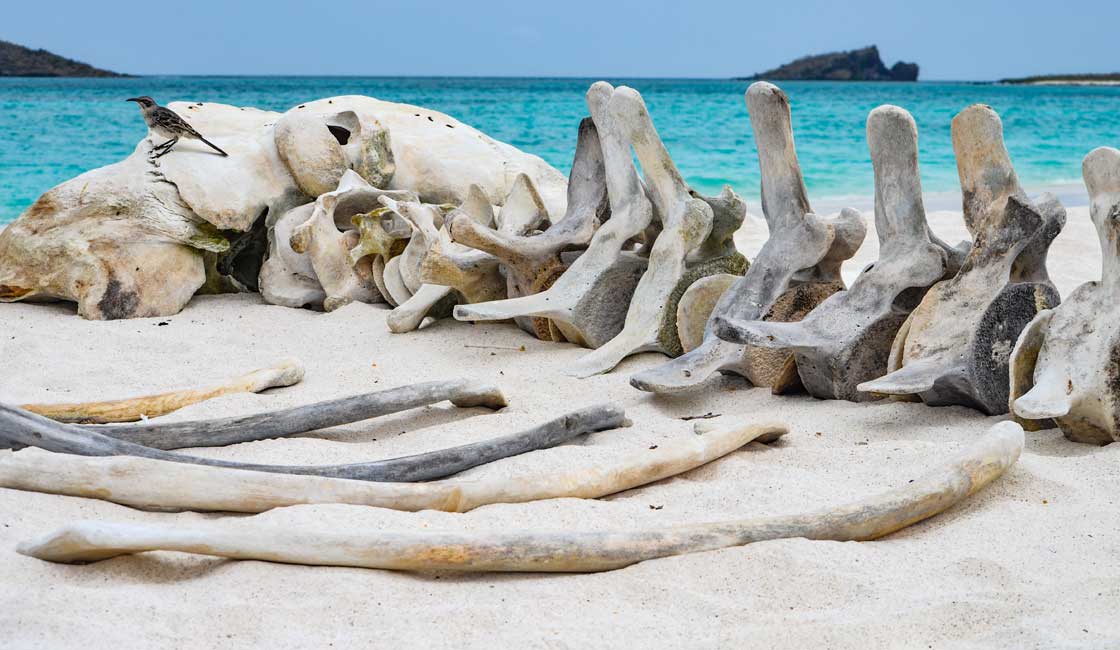
Española
Española Island is the oldest of all the islands and it was named in honor of Spain. Formed some 3.5 million years ago, it is the most southerly located of the islands and is a 10-12 hour boat ride from Santa Cruz. Due to its remote location, it has its own unique wildlife. It is the only place where the Waved albatross nest and there is a large population of sea lions that inhabit the precious white sands of the stunning Gardner Bay, voted as having one of the best beaches in the world.
Punta Suarez is another popular destination amongst tourists and it is the home to a range of different birds – it is a must for bird watching enthusiasts. The Swallow-tailed Gull is native to the island as is the Española Mockingbird. Diving is another popular attraction on the island as there is an abundance of marine wildlife – this includes the Galapagos eel, the Blackspot moray, the King Angelfish, the Red-lipped batfish, and there are also occasional encounters with the Hammerhead shark, the Whitetip shark, and the Eagle ray (they are not harmful in this environment). A large number of endemic species – the Española mockingbird, the Española lava lizard, and the waved albatross, to name a few.
Human Population: 0
Española Area: 60 km² or 37 mi²
Española Altitude: 206 m or 675 ft
Now you know which are the best Galapagos Islands to visit, it’s time to figure out which Galapagos Islands cruises visit those islands you want to see. Those travelers with limited time may realistically expect to visit 4 or 5 of the islands on their trip. For a chance to see almost all of the islands, why not consider a comprehensive 15-day Galapagos cruise? Contact our specialists for more information about your next Galapagos vacation.
While Rainforest Cruises aim to provide accurate and up-to-date information, we make no representations as to the accuracy or completeness of any information herein or found by following any link on this site. Rainforest Cruises cannot and will not accept responsibility for any omissions or inaccuracies, or for any consequences arising therefrom, including any losses, injuries, or damages resulting from the display or use of this information.




